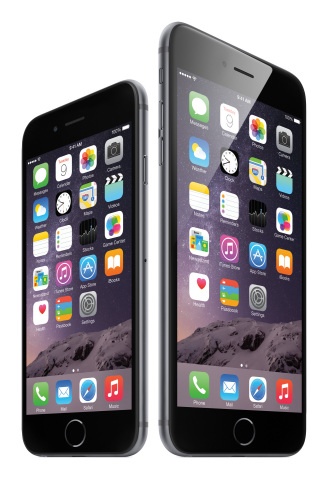Apple has announced iPhone 6 and iPhone 6 Plus, featuring two new models with 4.7-inch and 5.5-inch Retina HD displays.
The new smartphones feature a precision unibody enclosure of anodized aluminum that conforms with the shaped glass of the display. The iPhone 6 and iPhone 6 Plus are engineered to be the thinnest ever, delivering a bigger display in a design that is still comfortable to hold and easy to use, says Apple CEO Tim Cook.
Features include: the Apple-designed A8 chip with second generation 64-bit desktop-class architecture; advanced iSight and FaceTime HD cameras; “ultrafast” wireless technologies; and Apple Pay, a way to simply and securely make payments with just the touch of a finger. Both models include iOS 8.
The iPhone 6 features a 4.7-inch Retina HD display with 1334 x 750 resolution, providing 38% more viewing area than the iPhone 5s, while the iPhone 6 Plus features an even bigger 5.5-inch Retina HD display with 1920 x 1080 resolution, providing 88% more viewing area and nearly three times the pixels than iPhone 5s. The Retina HD displays offer advanced technologies including higher contrast for deeper blacks and dual-domain pixels for more accurate colors at wider viewing angles.
With second generation 64-bit desktop-class architecture, the all-new A8 chip offers faster performance and is more energy efficient, delivering higher sustained performance with great battery life, according to Apple. With Metal, a new graphics technology in iOS 8, developers can take performance of the A8 chip even further to bring console-class 3D games to iPhone. The A8 chip also includes a new Apple-designed image signal processor that enables advanced camera and video features.
Both models include the M8 motion coprocessor that gathers motion data from the accelerometer, gyroscope, compass and the new barometer, which senses air pressure to provide relative elevation. The M8 motion coprocessor can continuously measure your motion data, even when the device is asleep, saving battery life for fitness apps that use the sensors all day.
With iOS 8, motion data from M8 appears in the Health app so you can see how many flights of stairs you’ve climbed, or how far you’ve walked or run. Developers can use CoreMotion APIs [application programming interfaces] that take advantage of M8 and HealthKit to create apps that help you take better care of your health and fitness.
The iSight camera in the iPhones boasts a new sensor featuring Focus Pixels for faster autofocus. iPhone 6 Plus users will also benefit from optical image stabilization technology that compensates for hand shake in low light and works with iOS 8 to reduce subject motion.
High-definition video on iPhone improves with faster frame rates up to 60fps for 1080p video and 240fps for slo-mo, as well as continuous autofocus, cinematic video stabilization and time-lapse video. The FaceTime HD camera now captures over 80% more light with a new sensor, larger f/2.2 aperture and new features including burst mode and HDR video.
With faster LTE download speeds of up to 150 Mbps, iPhone 6 and iPhone 6 Plus users can browse, download and stream content faster. The new iPhones also support voice calls over LTE (VoLTE) as well as Wi-Fi calling. With support for up to 20 LTE wireless bands, the new models make it easier to experience high-speed networks around the world. Both iPhones also include 802.11ac Wi-Fi with speeds up to 433 Mbps and Bluetooth 4.0.
The iPhone 6 comes in gold, silver or space gray, and will be available in the US for a suggested retail price of US$199 for the 16GB model, $299 for the 64GB model and, for the first time, a new 128GB model for $399 with a two-year contract. The iPhone 6 Plus comes in gold, silver or space gray, and will be available in the US for a suggested retail price of $299 for the 16GB model, $399 for the 64GB model and $499 for the new 128GB model with a two-year contract.⁴
The iPhone 5s remains available for $99 for the 16GB model and $149 for the 32GB model; an iPhone 5c 8GB model will be available for free. iOS 8 will be available as a free software update starting on Wednesday, Sept. 17. Apple Pay will be available to US customers as a free software update to iOS 8 this October.



